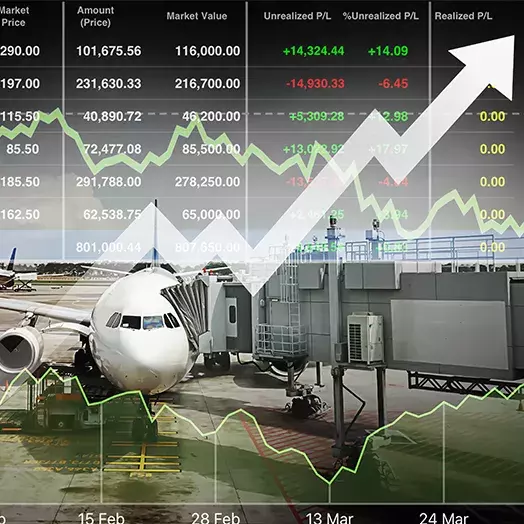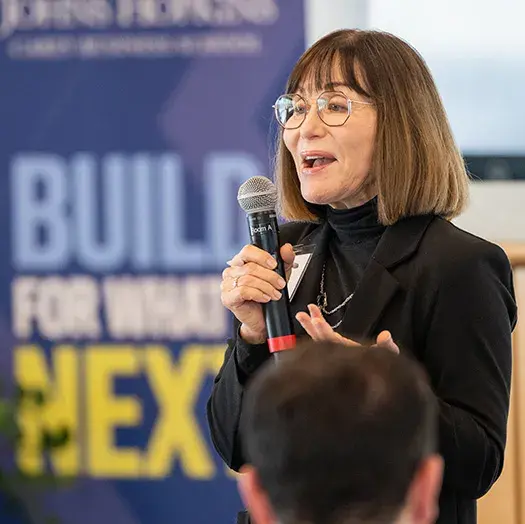Johns Hopkins Lecturer Terry Leitch offers insights into how the airline industry will recover from the pandemic

Pandemic Sends Airlines into Nosedive
The COVID-19 pandemic continues to pose challenges for every sector of society.
Few sectors have struggled as much as the airline industry. According to the International Air Transport Association, airline carriers are expected to see a record loss of $157 billion in 2020 and 2021.
In the following Q&A, Johns Hopkins Lecturer Terry Leitch offers insights into how the airline industry will recover from the pandemic. From 2001 to 2007, Leitch was senior director of risk management for Boeing Capital, where he designed a quantified risk pricing approach for aircraft financing. Before joining Carey Business School, he licensed his risk financing models to Marsh & McClennan and utilized it to advise the Export-Import Bank of the U.S. in its recent reinsurance purchase for its aircraft loan guarantee portfolio.
QUESTION: The COVID-19 pandemic has been very difficult for the entire travel industry, but the airline industry has been hit particularly hard. With restrictions and recommendations against on airline travel, what are some of the challenges facing the industry during this crisis?
Terry Leitch:
The biggest immediate problem for airlines is cash flow. The industry is highly levered, and they achieve this through borrowing against pretty much any asset assigned some measure of quality. This leverage has been accommodated by a finance industry that is attracted to the huge cash flow potential an airline can generate on a regular basis. There is a built-in cushion with employee and fuel costs, which are variable, but at the end of the day aircraft financing and lease costs and gate rental do not go away with a phone call.
These are contracts, which are on the books of institutions as assets, and those institutions have to make accounting changes if they modify their terms. Many of the lenders and lessors ae deep-pocket private companies, so public disclosure is not available, only rumor, which has it that lessees are paying 30 to 40 cents on the dollar.
One public leasing firm has reported numbers higher than that, closer to 80 cents on the dollar, but the wording was a bit engineered. One way to read it was the year's average payment so far was 80 percent, but that would include a few good months before the collapse. Airlines just cannot pay.
Medium-term, I think the airlines will be operating at a loss. They will not be able to fill the planes, will have to offer significant flexibility to travelers, and will not be able to charge fares sufficient to cover costs, let alone a suitable return. If you look at load and load versus profitability prior to the downturn, you see there is not much room for error.
Several analyses, such as the October 27, 2020, presentation by IATA regarding airline cash, show that pre-pandemic profitability was about 10-15 percent above the airline’s cost. A simple fact of airline economics: A passenger in a seat pretty much has a zero marginal cost for the airline. So, if you drop the number of passengers by a third to allow for social distancing you need to charge 50 percent extra to get back to your prior profitability. That is hard to achieve in a good market. That is why you see a number of airlines not offering this as an option, which is somewhat supported by the anecdotal study of known cases on long-haul flights not leading to transmission.
Longer term, I think there is a risk to the business model of the premium airlines in the U.S. because of their reliance on the premium business traveler. Premium business travelers pay extra for a better seat and schedule flexibility. With everyone working remotely and finding ways around the shortcomings, I think it highly likely that these customers may adjust, especially if this goes on for another year, to the current circumstances and those business travelers might not be there in the numbers needed to float a profitable business model. I think the multi-class air travel market is at risk.
Share this Article
I bring this up because this could be like a dike breaking. The major airlines have reserved all of the gates at most of the major airport hubs in the country. I know it looks like a lot of choices are available when you look at the airline signs while driving through the departure lane at these airports. In reality, there are really two or three flexible choices, even at large airports, and a few smaller niche players with limited gate access. It’s like the breakfast aisle in the supermarket. It looks like there’s a lot of choice, but in fact there are only four companies on the shelf plus some smaller granola offerings they let slip between the cracks.
So, if you take an airport like O’Hare in Chicago which is dominated by premium multi-service carriers such as United, Delta, and American, and flip a third of the gates to a Southwest model, it could be devastating for the fare rates for the premium carriers. A gate here or there isn’t a risk, but a full operating discount airline like a Southwest could be the end of the multi-service business model for some or all, especially if the airline has a credible network of other airports already available.
“The biggest immediate problem for airlines is cash flow. The industry is highly levered, and they achieve this through borrowing against pretty much any asset assigned some measure of quality.”
Terry Leitch, MBA, MS, Lecturer
You were with Boeing in 2001 during the industry downturn following the September 11 terrorist attacks. How does the economic impact of the 2001 crisis compare to the COVID-19 pandemic?
In 2001, there was not only economic impact but a perceived safety impact, as well as process changes as governments responded with new rules and technology to reduce the threats. The downturn was roughly a 25 percent drop in travel, which steadily recovered over a little more than two years. This time, we have an immediate drop from the pandemic event, which was closer to 90 percent in revenue passenger kilometers (RPKs). This is totally uncharted territory for the airlines. The drop during the Global Financial Crisis was only 10 percent, but the recovery to pre-crisis levels took five years via a very stagnant growth process.
As for the economy, tourism represents about 10 percent of global GDP, which has also dropped significantly with air travel. There are some domestic exceptions, such as China, but overall tourism is running at a fraction of 2019 equivalent levels.
In contrast, freight has grown significantly during the pandemic. A structural issue in this market is that the drop of passenger planes flying has severely impacted the availability of cargo transport since 50 percent of cargo travels in the hold of passenger planes, especially long-haul wide bodies, which are pretty much parked. There are currently passenger planes flying without passengers, “preighters,” in order to meet the freighter demand. In the post 9/11 environment, freight slowed along with the economy.
The airlines, airports, and aircraft manufacturers all have a stake in the broader airline industry. What are some of the challenges facing aircraft manufacturers due to the pandemic?
The aircraft order books are one of the biggest challenges. With decreased demand, aircraft manufacturers have no homes for the planes coming off the assembly line. This has been compounded at Boeing with the 737 Max 8 issues. Finding a home for equipment in a market well beyond needed capacity will likely be a significant near-term juggling act.
Longer-term, there are a few things operating in favor of the aircraft manufacturers. Emerging markets, which were a nice new player after 9/11 and the Global Financial Crisis, are likely poised to absorb some of the new planes as they return to their prior demand. The rebound in China is a good indicator.
It helps that the replacement rate for aircraft tends to go up in a downturn. The most efficient planes are the ones that get deployed first and the most efficient aircraft are the newer. New planes also help trim maintenance costs near term, which is an important benefit when managing up from a downturn. Typical replacement rates are around 2 percent of the fleet, but after 9/11 this went up to 4 to 5 percent. We will likely see this at play with airlines and manufacturers motivated to get the more efficient new planes into operation.
What to Read Next

research
Delivering a Pandemic Vaccine Poses ExtraordinaryHow long will it take for the industry to recover, and will it take longer for some portions of the industry to recover than others?
Travel markets will likely recover in three distinct stages: domestic, regional, and finally long-haul international flights. Domestic air travel is already running at 85 percent of pre-pandemic levels in China. As countries gain more control of the virus through health mandates or the vaccine rollout, we will see travel within their political border increase to levels closer to those prior to the pandemic.
Once domestic travel begins to recover, we’ll see regional moves to allow flights across political borders, say U.S. to Canada or U.S. to Mexico. These arrangements will be driven by bilateral relations and local convergence on rules. It should be noted, one of the biggest impediments to travel is the mixed bag of rules that are applied in the various legal jurisdictions, rules which can change overnight by fiat.
Long-haul intercontinental travel will be the last to return. This will require more unity on global travel rules or acquired herd immunity. This means that the wide-body aircraft market, with the exception of freight, will be the most challenged over near to medium term until health and political factors create more operational predictably. This has always been the case. Wide-body aircraft have always been the riskiest market since more seats means more potential to fly below capacity, and longer flights mean the political and cultural connections are thinner, which leads to greater potential for limited operating ability.
Earlier this year, the federal government provided $32 billion in relief for the airlines. Are there any other measures that can be taken?
Airlines are throwing off variable costs like labor and fuel as quickly as they can, but they still need cash. At a recent conference, it was noted that the airlines had become increasingly creative with asset-backed financing, and even using their mileage programs as collateral. These programs are estimated to be valued in the tens of billions, which makes me wonder if airlines are just flying airplanes to collect data. The bigger point here is that airlines need to defend their routes to protect the inherent value in their brand, and that takes cash. As I indicated before, the current operating environment is not profitable when you extrapolate the pre-pandemic cost structure.
It’s a balancing act for the airlines, burning down asset value via borrowing to defend the residual value of their brand and market position. One thing I airlines might want to address is pay levels. U.S. pay is higher compared to the E.U., which leads to higher cost structure and higher fares for comparable distances. This is difficult as the pilot union is quite a strong lobby, so the trade-off is more planes on the ground to avoid labor altogether versus pilots taking a pay rate more in line with the variable revenue of an airline. One thing is for certain, if there needs to be incentives, it needs to come from policymakers as airlines are running out of things they can finance to keep them aloft.
Near term, the planes likely won’t be flying, so the key thing the policymakers should address is the massive unemployment in the travel industry. As for helping the airlines, I guess that comes down to whether you see them as a strategic resource like phone and power companies. There is significant GDP generation in this infrastructure, but what does it take to keep it current without creating moral hazard? In some sense, the flight route rights are an incredibly valuable asset we have already granted the airlines and are a component of their underlying equity. What more should be done? Should we give public funds in order for airlines to protect their flight route assets? If the policy goal is to get back to normal as quickly as possible on the other side of this pandemic, then that would make sense. I am mixed on it, not for any fundamental public policy, but rather I think letting the airline route assets churn in takeover/makeover could lead to innovation and more choice.
Do you predict any lasting changes to the airline industry following the pandemic?
I think there is pent up demand for vacation travel, and recent holiday travel says that people are willing to travel despite the risks, so no changes here. I wonder what changes the work-at-home experience might inspire for a post-pandemic travel market. People and companies may find they like saving money and time if they’re able to effectively operate with less business travel. If that happens, the airline business models will be impacted for the full service, multi service class carriers. These airlines depend on higher fares for last-minute bookings and changes, so if that premium revenue stream is affected, it may affect their entire operating model. If this happens, I expect to see pressure for an airline in this sector to drop down to a Southwest Air model, single class, quicker turnarounds, and lower costs (union willing, or legally driven if through bankruptcy).
The watch word in aviation markets has always been resiliency. It is a market that has continually grown in one way or another since its inception, and it it’s unlikely to stop now. So, extrapolating from this, the names and faces may change, but probably the most surprising thing will be how much does not change from before.
How might the industry change in a broader way after the pandemic?
Industry and health scientists could come together to develop a solution, not just for COVID-19, but for any significant infectious disease. Global chains of airlines and hotels might become global monitoring sources for general traveler health without sacrificing individual privacy.
Better coordination of action is needed. Deciding to shut down travel between political boundaries is fraught with political problems, but businesses have much more latitude with much lower political impact. Businesses can act more quickly with less precise data and fewer constituents to answer to.
Risk sharing on a global basis makes sense such as an airline and hotels in other parts of the world contributing to the cost of shutdown in other parts of the globe, but it is hard to see how this can happen with current insurance market products, so maybe there is a potential change there as well. Probably the best route to something like this is an industry effort to coordinate data collection, analysis, and sharing to help establish the risk potential and impact mitigations with enhancements to business continuity products that focus on risk sharing in global travel as opposed to local conditions only.
More high-level strategic thought would be if the monitoring process was coordinated and somewhat open to researchers who could share epidemiology models for forecasting potential spread. It would be easier for business leaders to understand and act on information versus politicians, but currently the knowledge and coordination for this rests in government agencies. I think it would be a healthier if the travel industry imported some of this monitoring and participated in the decision making as opposed to simply being bystanders in the process and accepting the policies and laws they are prescribed.
Are there any “outside the box” thoughts you have on what we may learn during this period that could lead to permanent changes?
After 9/11 the climate scientists got a clear view of what was going on in the absence of jet contrails. There was missing temperature rise in the global data, but after 9/11 there was an immediate spike as air travel was suspended. This was due to a reduction in light reflecting clouds as the contrails “seed” the water particles with foreign matter to latch them together. I wonder what the climate scientists will find in the data after this dramatic drop and what it might mean for climate science and policy going forward for aviation and other industries.


